Notre Dame was dominating the efficiency game through 40 minutes, with Florida State surviving on a few massive plays. Then the strategy shifted, the Noles started putting long drives together, and suddenly the Irish were in a coin flip game. Below let’s dive into the good (Jack Coan’s debut and the passing game), the bad (run defense giving up big plays, then just giving up easy gains), and big lingering questions (the rushing offense, non-Kyle Hamilton secondary, and defensive scheme).
Despite the Irish’s second-half attempt to pull away, the game never reached garbage time so all plays were counted in the stats below. In keeping with advanced stats precedence and common sense, sacks are counted as passing plays. Confused? Check out this handy advanced stats glossary here or reach out in the comments.
Explosiveness
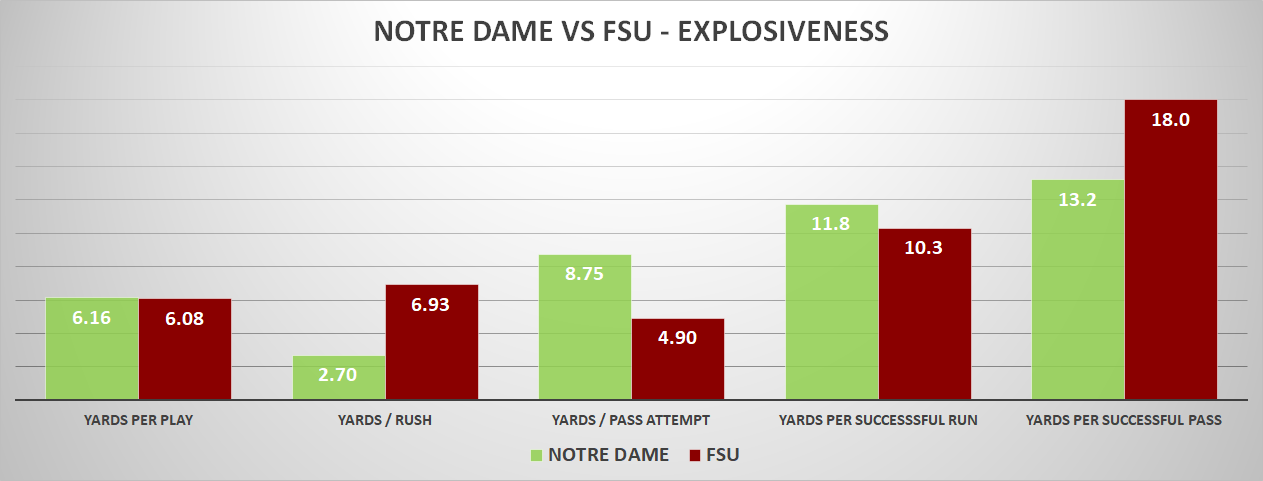
When the dust settled in Tallahassee everything appeared evenly matched, even if FSU and Notre Dame succeeded in diametrically opposed ways. Each time averaged just over six yards per play, created seven scoring chances, and finished with slightly below-average offensive efficiency. Both the Noles and the Irish featured extremely one-dimensional offensive production, with ND shockingly unable to run the ball with any consistency and Mike Norvell’s team predictably struggling through the air.
But the storyline far bigger than an even contest, especially for Irish fans, is how this game ended up in overtime. After a wild sequence featuring consecutive FSU Wildcat runs and then a failed 4th down conversion attempt, Notre Dame’s final touchdown put them up 18 with four minutes left in the 3rd quarter. At this point, Brian Kelly’s team was dominating the efficiency battle, with a success rate double Florida State’s (47.2% to 20%). The Seminoles were totally dependent on offensive misdirection and trying to create big plays, and to Norvell’s credit they successfully dialed up two long touchdowns to keep pace.
After this point, with Marcus Freeman’s defense shifting into predominant 3-down looks, FSU started running at will on the Irish. The Noles had a 50% success rate over their final three drives, with most of the damage on the ground even after McKenzie Milton’s entrance gave them a jolt of passing competence. Florida State was so dependent on big plays they hadn’t had a drive longer than six plays the entire game; their final three drives produced 17 points and were 15, 12, and 10 play possessions.
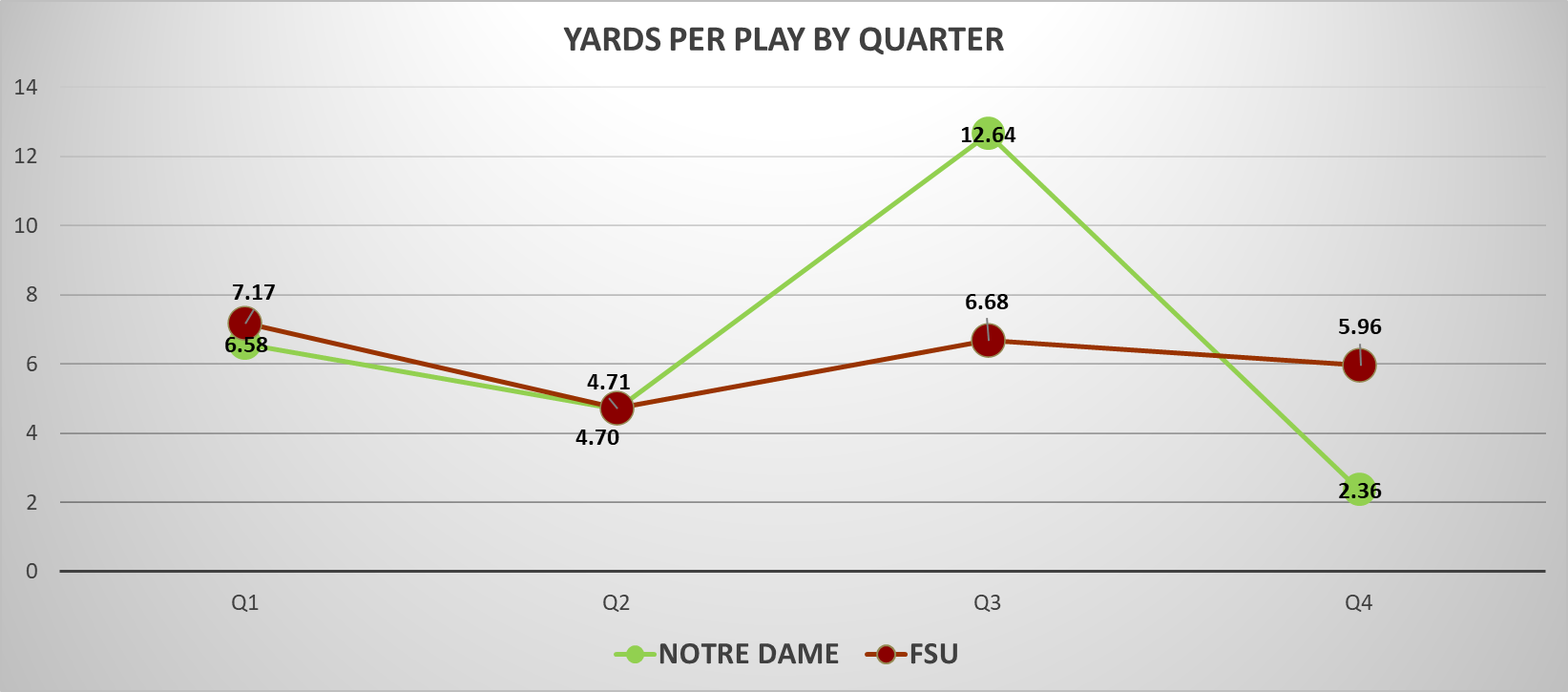
Meanwhile, the ND offense wasn’t dousing the Tomahawk Chop momentum either. After a majestic 3rd quarter, where offseason dreams of Jack Coan connecting downfield with Kevin Austin and Braden Lenzy finally manifested into reality, Tommy Rees parked things firmly in clock chewing mode. Despite game-long struggles on the ground, the Irish ran the ball on every first down they faced until suddenly the score was tied again. More to come on the running game struggles below, but Rees and company were lucky to survive the scoring droughts of the second and fourth quarters that featured a run-run-pass strategy.
ND had eight explosive plays in the passing game (receptions of 20+). Only one team averaged more in the first week and that was more than 20% of their season total last year
— Jamie Uyeyama (@jamieuyeyama) September 7, 2021
Thankfully Coan excelled in the stretches where the Irish were more aggressive, connecting on multiple explosive plays of his own. That included long scoring throws to Austin and Joe Wilkins and a few missed opportunities to Braden Lenzy. On a weekend where UGA and Clemson played a slugfest in large part due to an inability of their receivers to gain separation, the Notre Dame offense provided that encouragement that breakout seasons may be in store for multiple players.
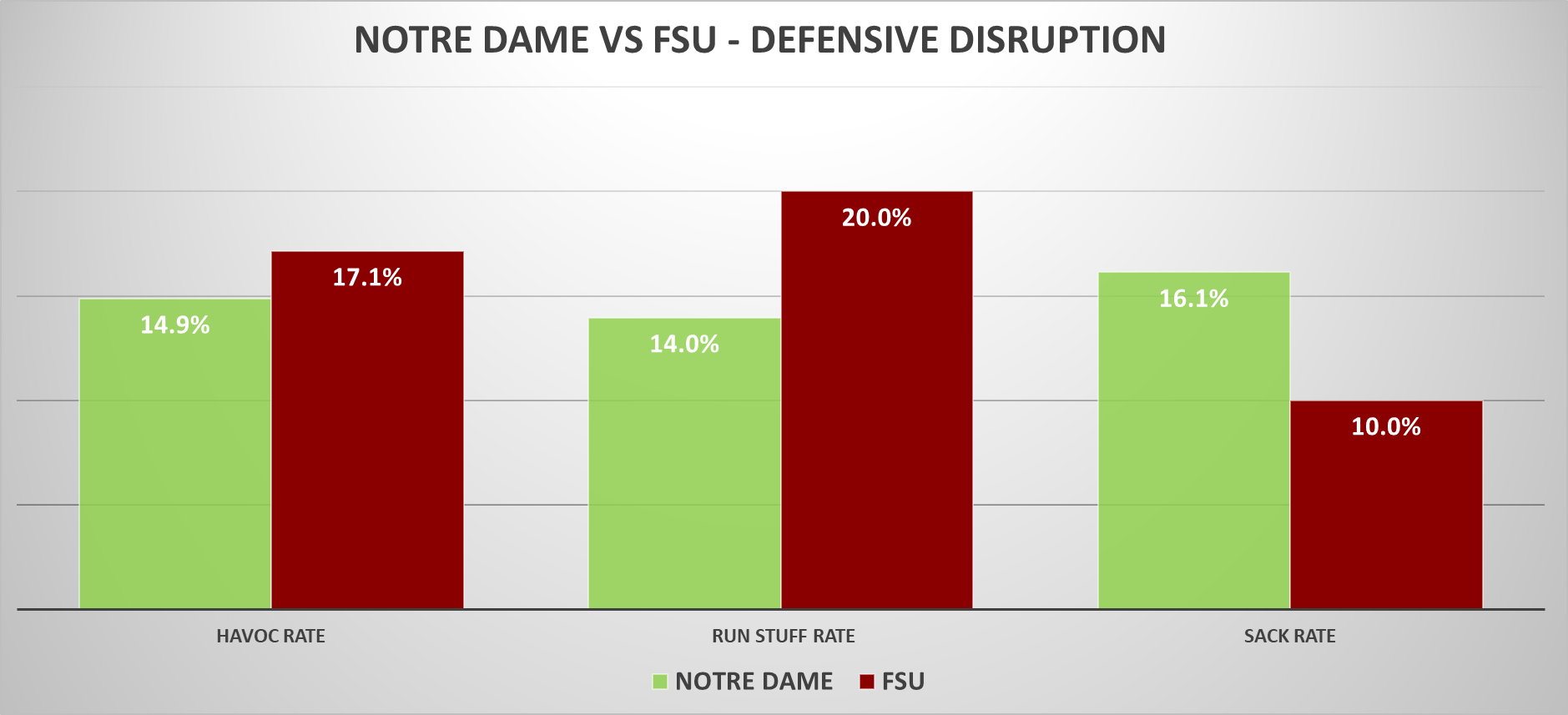
While the Seminoles out-edged Notre Dame in overall havoc rate (percentage of plays with a tackle for a loss, force fumble, or pass defensed), the Irish were dominating the category before Freeman removed his foot from the gas pedal and forgot where it was placed. The ND pass rush looked strong against an overmatched Seminole line, and there were numerous missed tackles for negative runs that until proven otherwise can be attributed to offseason rust and strong FSU ballcarriers.
As with all openers, it’s difficult to know how concerned to be about allowing the Noles to create so many negative plays. FSU’s defensive front is obviously improved, especially with UGA transfer Jermaine Johnson off the edge. A lot of offensive lines across college football struggled, and it’s easy to imagine the young Irish group gelling as the season goes along and exiting a hostile environment. Still, with the loss of Blake Fisher for a stretch, this is a potential red flag – the heart of the schedule features a slew of excellent defensive linemen highlighted by George Karlaftis, Myjai Sanders, Amare Barno, and Drake Jackson.

Above you can see the impact of some of the most explosive plays of the game from the excellent new site Game On Paper (it also updates live during games!). On the left are the biggest plays by estimated points added (EPA), prominently featuring FSU’s long touchdowns. While it’s a little counterintuitive, Corbin’s long TD run actually was worth more than a touchdown in expected points, as he scored from an area and down and distance where the Noles had negative expected points prior to that play. On the right, you can see the most important plays by the impact on win probability. While these estimates as a whole always feel a little suspect, these directionally feel pretty accurate as the most important plays swinging who was likely to take home the W.
Efficiency
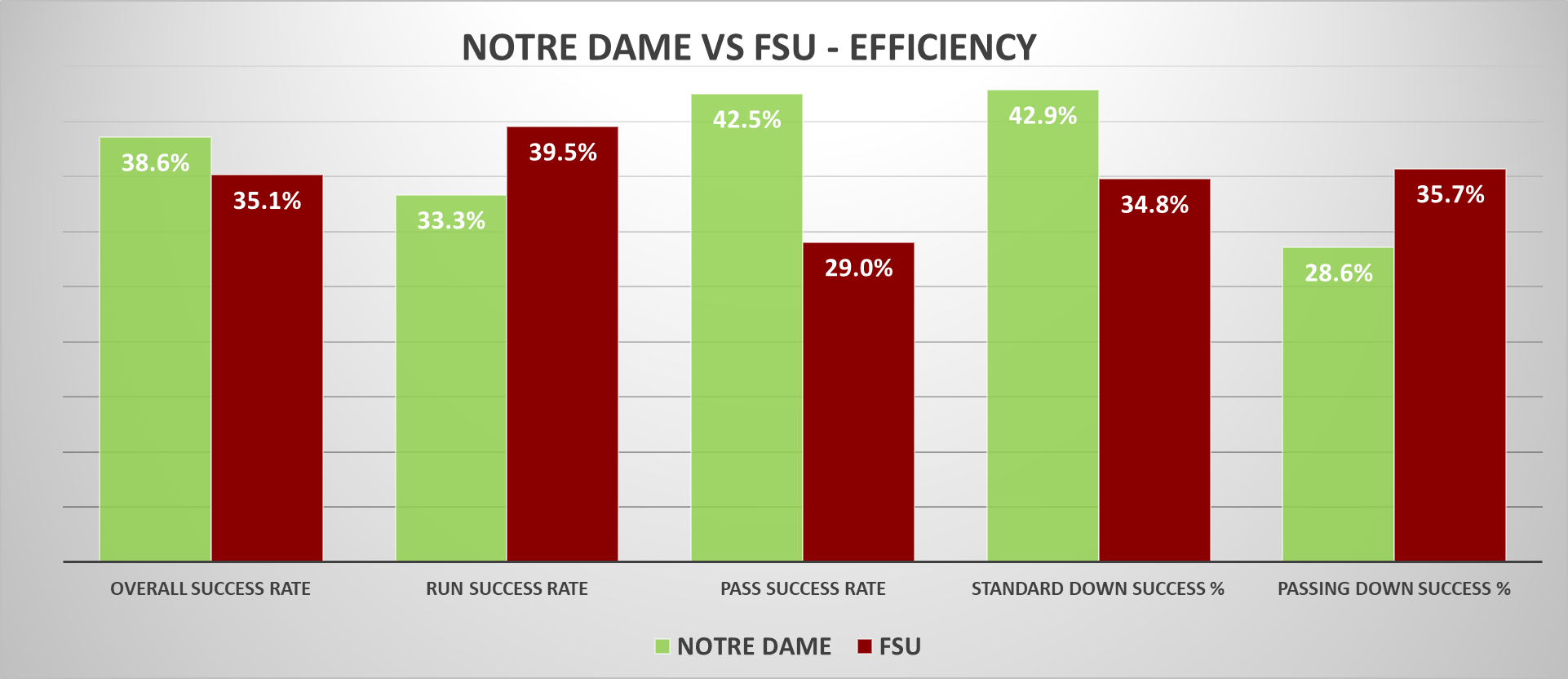
The success rates on Sunday night were not glamorous across the board, but it was Coan and the Irish passing attack that moved the ball most efficiently. While there were a few missed connections, Coan’s 8.75 yards per dropback would have been the 3rd highest mark in 2020, trailing only Ian Book’s games against Pittsburgh and Boston College. When things were working well, Coan and Rees were mixing together some high percentage throws letting playmakers like Michael Mayer, Kyren Williams, and Chris Tyree do things in space with some attacks downfield to Austin and Lenzy sprinkled in.
The Notre Dame offense leaned on Coan far more than anticipated, and despite the fairly high sack rate and stuff rates allowed the Irish were excellent staying on schedule. The Irish average 3rd down distance was just 5.5 yards to gain, but they converted only 6-17 attempts. Even more jarring on the heels of 2020 was how quickly the Notre Dame offense shied away from third down runs. The Irish ran eight plays on 3rd and four yards or fewer to gain; seven were passes, with one lone failed rushing attempt on 4th and 1. Coan was very effective through the air in these scenarios, but over the course of the season the Irish will need to find ways to convert these power run scenarios as defenses sell out less and are aware of the passing threat.
It will be interesting to see how the offense continues to evolve – as Eric mentioned in his recap, 23 of 39 passing targets to Mayer and the running backs is a heavy volume. Despite being on the field nearly the entire game, there were no targets or touches for Avery Davis or Lawrence Keys out of the slot. If the running game between the tackles continues to be stagnant, mixing in more jet sweep action with Davis, Keys, and Lenzy has to become an additional element to compensate for the loss of a running threat at QB. With Kevin Bauman out with a fracture suffered against the Seminoles, continuing to spread things out with wide receivers feels like a more realistic path forward than a return to the 12 personnel groupings of 2020.
Finishing Drives, Field Position, & Turnovers
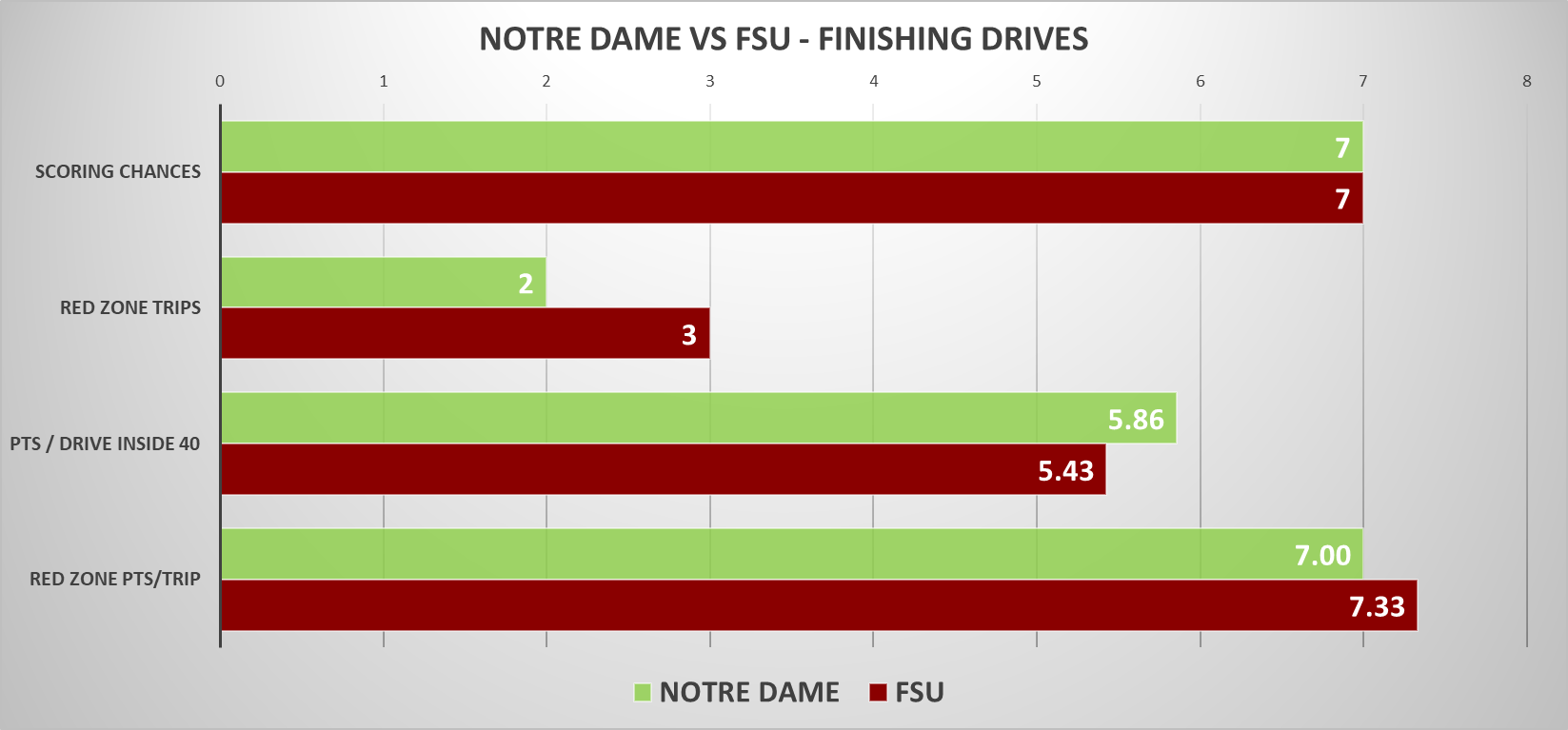
Both teams were able to generate similar scoring chances (first downs inside the opponent 40), and there were few red zone opportunities for either team with both scoring so often on explosive plays. If anything the missed opportunity for Notre Dame came early in the game not creating more scoring chances – the first four ND possessions all crossed midfield but only led to seven points. It stings for the defense not to generate any red zone stops, especially after forcing Florida State into some passing downs in the red zone.
Thanks in large part to their interceptions and strong defensive start that pinned Florida State deep in their own territory, the Irish enjoyed a solid field position advantage. The average Notre Dame drive started at their 33-yard line while the Noles average starting position was their 26.

The advanced stats see turnover luck siding with the Irish, as all three passes that Notre Dame defenders were credited with pass breakups on were converted into interceptions. Both teams were lucky not to lose any fumbles with some bad snaps and clunky exchanges deep in their own territory. However, what didn’t make the box score were the multiple near-miss Seminole fumbles that were overturned by replay. In general, Coan kept the ball out of danger, with just two passes broken up besides the interception on the end of regulation Hail Mary attempt.
On to Toledo
While some beat writers have thrown out the idea that Notre Dame’s recent season openers often tell the story of the season, that doesn’t feel like the case to me. Last year the Irish struggled with Duke before pulling away late, and the running game sputtered to less than five yards per carry. Two years ago the Notre Dame linebackers looked lost and were a huge area of concern, then Drew White and Jeremiah Owusu-Koramoah shut down UGA’s running game in Athens a few weeks later. It’s really easy to write narratives based on the only football we’ve watched in months, but we simply still have tons to learn about this team. We still hardly know much about Florida State either to properly contextualize what we saw on Sunday!
Still, there’s some reasons for optimism and pessimism that stand out and cause lingering questions. A few of the areas that we’ll be able to confirm as real or bust as myths in the next weeks:
Offensive Line: One-game blip or real concern?
The offensive line was already one of the shakier position groups before losing their starting left tackle. We’ll see how long Blake Fisher is out, but the depth in the position room is a concern to pair with the performance on Sunday. For as bright as their futures may be, it’s probably not ideal for the left side of the line to be Michael Carmody and Rocco Spindler this season.
Still, there are many reasons to believe the unit will settle in. The group hadn’t taken real snaps together ever or experienced a real gameday environment in two years. Brian Kelly alluded to issues getting off the ball at the right time together, and the Irish will not play in a tough road environment for another month. Communication and coordination can solve many of the issues from Sunday’s game, and if not creativity from Rees can help.
What’s the real offensive identity?
While Coan was brilliant in his debut, if the running game continues to be unreliable that’s a ton of pressure on the quarterback and receivers to carry this offense. The experience at QB and pedigree of the skill position players is there, but all it takes to derail a pass-reliant offense is some bad weather on the wrong day.
The offense’s floor is still very high – Mayer, Williams, Tyree, Austin, and Lenzy are simply too much for most teams. Few if any defenses on the schedule can adequately defend the Irish on the ground and through the air – FSU made the smart bet to make Coan and the Irish passing attack beat them, but it still cost them. But the Irish have paid lip service to the idea they are a physical offense that punishes teams on the ground, and it will be fascinating to see how stubborn they are trying to prove that or adjust to this team’s receiving talent.
Freeman gets a free pass, but will there be more growing pains?
The defense performance was the polar opposite of the Clark Lea experience in a number of ways. While the bend but don’t break could be frustrating, the common pattern under Lea was typically giving up more drives early and then taking away what was successful in the second half. The FSU game played out in the opposite way, and the adjustments after giving up a few big plays appeared from the outside like a panic move versus sticking to the script and forcing Travis and FSU to prove they could replicate their big plays.
There have to be some concerns at this point about the personnel and way they were used on Sunday too. If you told any Notre Dame fan in the spring that the linebacker snaps would heavily feature JD Bertrand and Isaiah Pryor, they’d be concerned. While both flashed some promise and weren’t bad, the position group outlook has changed significantly with the loss of Marist Liufau and the transition to a new defense could be bumpy. The outlook for the cornerbacks still feels murky as FSU’s lack of dropback passing attack barely tested the group, although the tackling was solid in run help.
On the other hand, all of the dominant possessions from the defense still count – the line was extremely disruptive, screens and passes to the perimeter were regularly sniffed out, and Kyle Hamilton is the ultimate eraser on the back end. Teams without a mobile quarterback will struggle against the pass rush even more. The tackling issues from Sunday are low-hanging fruit on the way to solid improvement and not shocking in a season’s first game. Freeman’s reputation and track record mean far more than a bad half, and he’ll adjust moving forward to the Irish defensive strengths and opponents.




Me opening these every week during the year:
Great write-up — before reading I was expecting to see a little more of an edge for ND in most categories and was a little surprised to see how even things were for the teams across the board (except for the ND advantage in passing and FSU advantage for running).
After watching enough football over the years, I think that my preference is for a Lea-esque bend but don’t break type of strategy over an attacking Freemen-esque approach. While Lea’s approach can sometimes feel like death by a thousand paper cuts as a team moves down field, the big advantage is that you can keep making small adjustments and just need to create one big stop on a 3rd down. While the attacking defenses might seem cooler, the potential for giving up big plays is something that I don’t like about it.
The metrics favored ND pretty strongly through the first 40 minutes of game time. Run game success was still lacking, but otherwise we were moving the ball pretty well and aside from two big plays stopping them pretty well. Jamie Uyeyama at ISD pointed out that the D had a 27% havoc rate in the first half (really good!) and an 8% rate in the second half (really bad!). I’m going to go out on a limb and guess it was close to if not dead on 0% during the two drives we were in 3 down.
The Lea defense seems more likely to beat all the bad teams but lose to the good teams. Theoretically the Freeman defense gives you a chance to disrupt those great offenses, but then you set yourself up for trouble if you allow a few big plays against the lesser teams. I don’t think we would have ever won a title with the Lea defense; but we might not get to the playoff if the Freeman defense doesn’t also feature some fundamentally sound tackling. Hopefully that was just week 1 rust.
Man the passing attack was enjoyable, and there was still more room for improvement. 2 Mayer drops. Several underthrows on deep balls. And on one of the few plays were Coan tucked and scrambled, Lenzy beat his man badly down the field. I don’t know how good/bad FSU’s pass defense is supposed to be, but I think we’ve got absolutely elite upside in the passing game.
I do think this team’s best offensive strength will be spreading things out and passing into the mismatches. If Lenzy and Austin turn into what we’ve been hoping and waiting for, you simply aren’t going to be able to take away Mayer, those two, and Kyren / Tyree in the flats.
The question is really if what we saw Sunday is one of Coan’s best games of the year or his baseline. While he underthrew a couple he generally kept the ball out of danger despite good pressure – he didn’t have many bad reads or force throws as he was going down or feeling the heat. He’ll definitely face tougher defenses, although FSU’s DL and pass rush seem much improved. Their reputation was mostly that the linebackers were an area of concern and the secondary is pretty young but talented.
Great writeup as always. A couple thoughts:
1. We were this close to a Michigan 2011 redux, which would have been absolutely crushing. The fact that ND pulled this out with some clutch heroics and a bit of luck, at night, on the road, in an electric stadium, with a team that definitely still needs time to gel, speaks highly to where this team is mentally. That’s encouraging.
2. I’m less panicked about Freeman’s playcalling than I was on Monday. FSU’s offense gave us a fair bit of trouble last year too, so my comment that Freeman looked like a downgrade from Lea is probably not fair. Relatedly, I think Lea adopted a similar strategy at the end of Southern Cal 2019 — surrendering the run to prevent the back-breaking pass. It worked, but just barely. So I’ll back off on Lea/Freeman comparisons for a bit. HOWEVA….
3. Kelly’s postgame comments about the defensive philosophy make me nervous. Complex gap assignments and a focus on havoc rather than fundamentally unimpeachable bend-but-don’t-break defense is an approach I’m just never going to be comfortable with. Trading an approach that wins 90% of games but can’t beat Bama for an approach that causes heart attacks but maybe, theoretically, possibly might beat Bama is not a smart trade, I think. Offense is our issue with beating Bama, not defense.
Much appreciated!
On #3, I wonder how much of those comments are BK covering for his DC and players through growing pains. The theme all spring and fall was how much more simple Freeman’s defense was, now it’s more complex? One of those isn’t right.
I do think a lot of the aggression can be dialed the right way depending on the opponent. What FSU did was very much in line with their 2020 with Travis starting – very flawed but capable of breaking the big play and dangerous on the ground. Other teams may not be as capable of exploiting our moments not executing well and have the defense become game-enders if things get better down the stretch.
The best defenses most years aren’t bend but don’t break but overwhelming with their pressure and then steady enough on the back end to not give up many big plays. I’m still holding out hope the good parts the defense flashed on Sunday can remain while cleaning up the mistakes that gave up the big plays and maybe aren’t always the cost you pay in Freeman’s defense.
Hello all. Long time reader first time commenting.
You beat me to it. BK’s comment struck me as odd given what the players were saying during spring. If I recall, the LB’s were saying Freeman’s system was much simpler than Lea’s freeing them up to play faster without so much thinking.
Frankly, had the tackling been better in the 1st quarter and Mayer catches the 3rd down pass ND is looking at 14–0 or 21-0 lead at the end of the 1st quarter. The D was living in the backfield but kept whiffing.
Do we get the half square of doom that shows how unlikely an 10-2 season is at this point?
I think it was the Win Probability Matrix.
BRENDAN! THE CHART!
I am just wondering if all the blame can be on Freeman and Rees for the 4th quarter conservative mode. BK is notorious for shutting it down with aa fairly large lead. Didthe edict come from the top? I guess you can say the way Freeman and Rees executed the slowdown, maybe they wee responsible. Any thought?
I don’t think the directive to slow down came from BK, but I do think he could’ve said “WTF guys” and directed them *not* to slow down, if that makes sense. All stuff I’m sure they’ve discussed since.